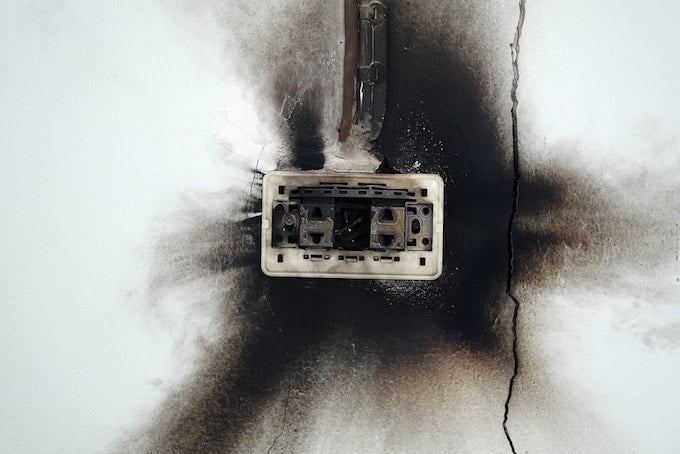Getting mains power to your shed transforms a simple garden building into a fully functional space for work, hobbies or storage. With a proper electrical setup, you can power tools, equipment, lighting, heating and security systems, making your shed far more useful.
Any electrical work must be carried out by a qualified electrician and correctly signed off – it’s not a DIY job. Here’s how to go about getting power to your garden shed.
Getting mains power to a shed, at a glance:
- Make sure you meet electrical safety regulations.
- Find a Part P-registered electrician.
- Plan your shed’s power needs in advance.
- Save money by digging your own trenches.
- Have your electrician lay the outdoor cables.
- Protect the cables with trunking.
- Have your electrician fit the key electrical components.
- Choose lighting, heating and power options.
1. Make sure you meet current electrical safety regulations

Electricity is dangerous; attempting DIY installation without proper qualifications puts you and your loved ones at risk – and it’s against the law. Section P of the Building Regulations states that installing electricity to outbuildings, including sheds and greenhouses, is a notifiable task. You must provide building notice or submit full plans of the installation before any work begins.
Once completed, the work must comply fully with Building Regulations and be signed off by a “registered competent person, registered third party certifier, or building control body”. Unless you’re a registered electrician yourself, you need a Part P compliant professional to handle the job.
If you’re still on the fence about hiring a qualified electrician, consider the long-term consequences. Imagine selling your house and discovering that the non-compliant electrical setup in your shed is complicating the process. Investing in a properly qualified electrician from the outset ensures peace of mind and future-proofs your property.
2. Find a qualified electrician
To help combat the risk of dangerous and poor quality work, the government introduced a consumer safety mark scheme in 2014, consolidating all officially recognised trades registration schemes under one umbrella.
The Registered Competent Person website is another useful tool. Use the search function to locate a qualified professional in your area. According to the scheme, every electrician listed on the database meets strict qualification standards and undergoes regular assessments by their Competent Person Scheme Operator to ensure they remain fully compliant and up to date with safety regulations.
A qualified and registered electrician will:
- Ensure the installation meets Part P regulations.
- Install RCD protection to prevent electrical faults.
- Issue a certificate of compliance, proving the work is safe and legal.
Be aware that, as with any trade, there are cowboy electricians out there. Red flags to watch for include:
- Suspiciously low quotes – get multiple quotes and if one quote is much cheaper than the others, that’s a warning sign.
- Willing to start immediately – good electricians are usually booked weeks in advance, so do some further research if that’s not the case.
- Cash-in-hand jobs with no receipt – if there’s no paper trail, you have no protection if things go wrong.
- No references – always check previous customer reviews.
3. Plan your shed’s power needs in advance

Right now, you might only need a single socket for a laptop and a light to see what you’re doing, but it’s worth thinking ahead. What if, down the line, you want to turn your shed into a fully equipped workshop? Or maybe convert it into a garden office, craft space or a recording studio? If you store valuable items inside your shed you might want to install security lighting or an alarm system.
Planning in advance will save you hassle later. Sketch a layout of your shed, including any internal walls, and mark out where sockets, switches, lighting and other power points should go. Think about future upgrades so you won’t need expensive modifications later on. If you’re digging trenches for an electrical installation, it might be sensible to think about connecting to the internet as well.
Having a clear plan will make discussions with your electrician much easier, allowing them to advise on the safest and most efficient installation.
Additionally, since your electrical work will require building regulations approval before any work begins, your electrician can guide you through the process with your plan in mind. You can find more information on the gov.uk site.
4. Save money by digging your own trenches

Although the actual electrical work must be done by a professional, you can save money on labour by preparing the site yourself. One of the biggest tasks is digging the trench for the underground cable. There’s no reason why you can’t help with this, but make sure you consult with your electrician first!
- Mark out the cable route using pegs and string. Make sure you avoid existing pipes or utility lines.
- Check the depth requirements – there’s no legal minimum depth, but Health and Safety Executive guidelines suggest 450mm for domestic gardens and 600mm for driveways or vehicle-access areas.
- Dig the trench to the required depth, keeping the edges as straight as possible.
- Lay a sand base at the bottom to protect the cable from sharp stones.
- Once the electrician installs the cable, it’s worth adding a warning tape layer before refilling to alert future diggers.
- If your trench crosses a pathway or driveway, your electrician might recommend running the cable through conduit piping for extra protection.
5. Have your electrician lay the outdoor cables
Using the right cable is essential, both for safety and durability. The best option is a steel wire armoured (SWA) cable, which is specifically designed for outdoor and underground installations.
SWA cables have a tough outer layer of steel wiring, making them highly resistant to weather, impact, rodents and moisture. The protective design means the cable stays safe and undamaged, even when buried underground for long periods.
The correct cable thickness depends on your power needs – your electrician will judge the appropriate size based on the number of sockets, lights and appliances you plan to use. If you’re thinking of expanding your electrical setup in the future, let your electrician know and he can choose accordingly.
6. Protect cables with trunking
To keep electrical cables organised and protected above ground, your electrician may install plastic or dado trunking. Trunking shields cables from moisture, accidental damage and general wear.
The right trunking size is important to prevent overheating and allow for future upgrades. Your electrician will select an appropriate size based on cable thickness and power requirements, ensuring compliance with BS 7671 wiring regulations. Generally, 25mm x 16mm trunking is used for smaller installations, while 38mm x 25mm trunking might be required for higher-capacity wiring.
7. Have your electrician fit the key electrical components
Once the groundwork is done, your electrician will install the key electrical components:
- Consumer unit (fuse box) – your shed needs a dedicated, RCD-protected unit to safely distribute power.
- Standard UK wiring colours: Brown = Live; Blue = Neutral; Green/yellow = Earth.
- Weatherproof sockets and switches – all fixtures must be outdoor-rated to prevent moisture damage.
8. Choose your lighting, heating and power options
Once power is connected to your shed, you can have efficient lighting and power solutions installed. Here are some of the options to consider:
Lighting choices
- LED lighting – the best option for energy efficiency and durability.
- Motion-sensor security lighting – ideal for safety and deterring intruders.
Heating options
- Tubular heaters – excellent for providing gentle background warmth.
- Solar air heaters – a cost-effective off-grid alternative.
Smart power solutions
- Smart plugs and remote-controlled sockets – let you turn appliances on/off remotely.
- Smart lighting – can be controlled via timers or smartphone apps.
- Wi-Fi extenders – providing internet access to your shed, ideal for offices or workshops. To learn more about getting your shed online, read our How to connect a garden shed to the internet article.
Running electricity to your shed increases its comfort and functionality, whether for DIY projects, a home office or security improvements. But remember to hire a qualified electrician and make sure you comply with all regulations.
MORE HELP
Visit the Waltons help pages or the Waltons garden building how-to guides for advice, tips, and all things sheddie.




